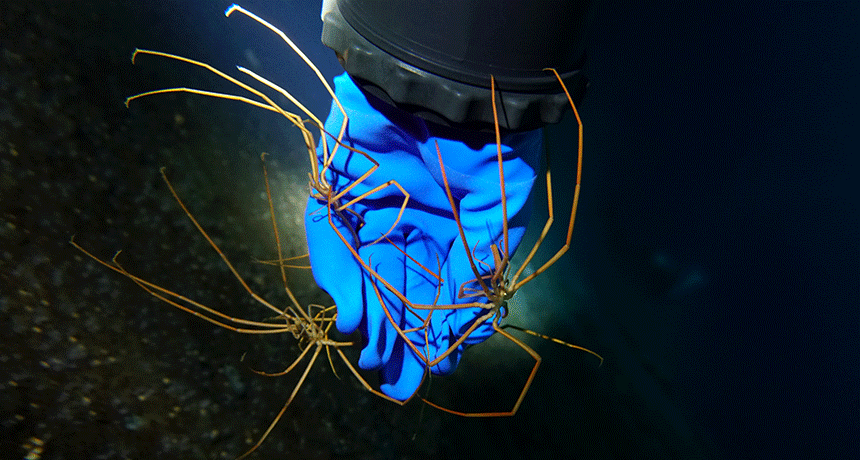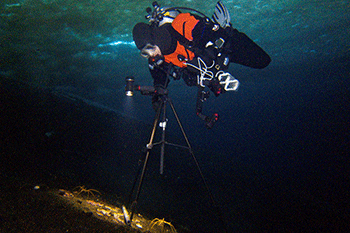Giant Antarctic sea spiders breathe really strangely
These creepy-crawlers absorb oxygen through their skin and pump blood with their guts

Giant sea spiders may look strange, but their circulatory system is even weirder, new data show.
Tim Dwyer
By Ilima Loomis
Sea spiders just got weirder. The ocean arthropods pump blood with their guts, new research shows. It’s the first time this kind of circulatory system has been seen in nature.
It’s been no secret that sea spiders are bizarre — and more than a little creepy. Full grown, one could easily stretch across a dinner plate. They feed by sticking their proboscis into soft animals and sucking out the juices. They don’t have much room in their bodies, so their guts and reproductive organs reside in their spindly legs. And they don’t have gills or lungs. To cope, they absorb oxygen through their cuticle, or shell-like skin. Now scientists can add an especially odd circulatory system to this list.
Amy Moran is a marine biologist at the University of Hawaii in Manoa. “It’s been unclear for a long time how they actually move oxygen through their bodies,” she says. After all, they animals’ hearts appeared too feeble to do the necessary blood pumping.
To study these animals, Moran and her colleagues traveled to the waters around Antarctica. There, they dove beneath the ice to collect them. They harvested several different species. Back in the lab, the researchers injected fluorescent dye into the animals’ hearts, then watched where the blood went when the heart was beating. The blood went only to the animal’s head, body and proboscis, they found — not its legs.

Inside those long legs are tube-like digestive systems, similar to intestines. The scientists took a closer look at those legs. They saw that as the spiders digested food, the guts in the legs contracted in waves.
The researchers wondered if these contractions helped pump blood. To find out, they inserted electrodes into the animals’ legs. The electrodes used electricity to spark a chemical reaction with oxygen in the legs’ liquid. Then they measured the oxygen levels present. Sure enough, gut contractions were moving oxygen around the body.
In another test, the scientists put sea spiders in water with low levels of oxygen. Contractions in the animals’ leggy guts sped up. This is similar to what happens in people deprived of oxygen: Their heart beats faster. The same thing also happened when they studied several species of sea spiders from temperate waters.
There are a few other animals, such as jellyfish, in which the gut plays a role in circulation. But this has never been seen before in a more complex animal that has separate digestive and circulatory systems, Moran says.
She and her team described their findings July 10 in Current Biology.
Louis Burnett is a comparative physiologist at the College of Charleston in South Carolina. He, too, finds the new sea-spider observations exciting. “The way they [circulate oxygen] is unique,” he says. “It’s a pretty novel finding because not a whole lot is known about sea spiders and how they breathe.”
Don’t fear the sea spiders
If you find sea spiders creepy, you’re not alone. Moran says she has always “had a thing” about land spiders and is especially afraid of them jumping on her. But once she spent time with sea spiders, she got over her fear. For one thing, although they have eight legs, they’re not really spiders. Both are arthropods. But spiders belong to a group called arachnids (Ah-RAK-nidz). Sea spiders are something else: pycnogonids (PIK-no-GO-nidz).
Sea spiders are colorful and very slow. Moran even finds them kind of cute. Like cats, these animals spend a lot of time grooming themselves. And the males care for the eggs. To do this, they shape the eggs into “donuts” and wear them on their legs while crawling around.
“It took me a while to get used to them,” Moran says. “But now I find them quite beautiful.”







